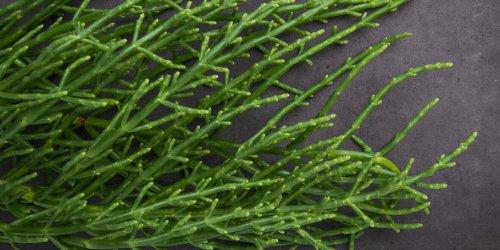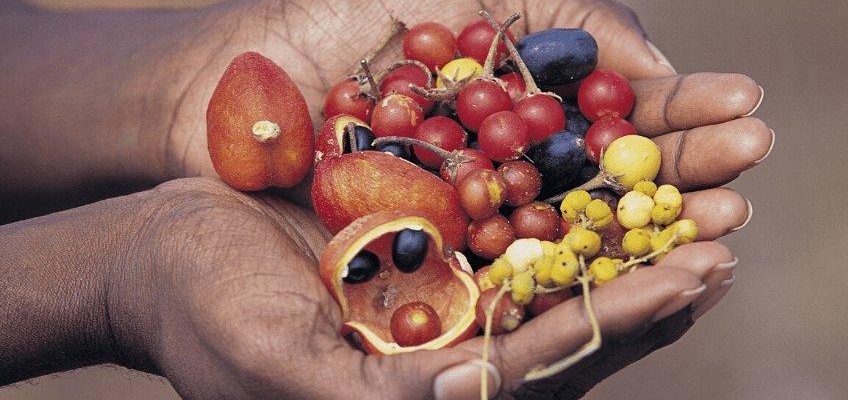Article by Jeremy Lemon, DPIRD Albany
Australian native bushfoods are set to go mainstream, thanks in part to growing global trends in nutrient-rich “superfoods” and a return in both popularity and consumer awareness to foraged and native ingredients on Australia’s culinary scene. These factors, coupled with other agricultural pressures such as drought, have led farmers to look at alternative crops and emerging markets which are yielding positive returns.
In 2016, René Redzepi, head chef at the second best restaurant in the world, Noma, ignited a wildfire of interest in Australian native produce. Redzepi, famous for his dishes of foraged and native ingredients in his homeland Denmark, opened a 10 week pop-up in Sydney which featured a culinary tour of Australia’s best native produce: from abalone to gubinge (the Kakadu plum). Since this time, the appearance of Australian native bushfoods on restaurant menus has continued to grow, as has demand for local producers. According to Australian Native Food and Botanicals, international demand for Australian bushfoods is also at an unprecedented level.
Bruce Pascoe, author of Dark Emu and aboriginal historian, saw both the monetary and environmental value in bushfood crops when researching his book. His study into the agricultural practices of Aboriginal Australians inspired him to start a Pozible campaign and launch the Gurandgi Munjie Food Company, cultivating kangaroo grass, native millet and murnong (yam daisy). He comments, “they’re highly nutritious – much more so than wheat – they promote good digestion, and most don’t have any gluten.”
But the big plus is their effect on the environment. “I don’t know why it has taken Australia so long to consider these plants, but it’s now more important than ever. As they are perennial, you don’t need to turn over the soil, and they have massive root systems, so they are drought-resistant.”
While kangaroo grass and native millet are yet to see significant market demand and are in a primarily experimental phase commercially, ‘sea asparagus’ or samphire shows commercial bush food potential for salty inland farmland, particularly in Katanning.

In a recent ABC Great Southern article, Katanning farmer David Thompson discussed his success in cultivating samphire on his otherwise non-arable land. According to the WA Department of Agriculture and Food, samphire plants have a high tolerance to both waterlogged and saline soils.
Once established, along saline land, the samphire will spread rapidly if protected from grazing pressure. The samphire stems are best harvested in summer, when they are fleshy, green and aromatic.
Through his business Moojepin Foods, David Thompson is on track to setting up a samphire industry for WA, which he describes as “the capital of the world for salt affected land.” Mr Thompson believes there’s huge export potential in already established northern hemisphere markets, like the Netherlands, where samphire is considered a diet staple.
According to AgriFuture’s Farm Diversity tool, other Australian native bushfoods suitable for the Peel, Great Southern and South West regions include the Bush tomato (Solanum centrale), Desert Lime, Muntries and Quondong. Fact sheets on each of these native bushfoods can be obtained at https://anfab.org.au/main.asp?_=Fact%20Sheets.
Australian Native Food and Botanicals singles out bush tomato as one of the most marketable products emerging from the Australian native foods industry. While the mature yellow fruit can be eaten fresh, bush tomato is usually used in its dried form.
It has a distinctive raisin/caramel introduction with a strong spicy aftertaste, making it ideal for chutneys, curries, salsas and as a crust on meat. Ground, it can be found in bread mixes, herb blends, pasta, relishes, dressings, sauces and dukkah.
A major strength of the bush tomato is its unique and intense flavour, which retains its integrity in many applications and in relatively small ratios to total ingredient mass. This characteristic is a double-edged sword: it is an attractive ingredient providing a distinctive flavour at a relatively
economical use and cost, but relatively small quantities are currently required by the food industry.
Products are available in specialty tourism and food service outlets, but its presence is increasing in mainstream supermarkets. The export market is also important, with seasonings and flavourings available throughout Europe, the UK and Asia.
Currently, the fruit is primarily sourced via wild harvest, which accounts for up to 80 per cent of production in good years. Production is highly erratic from year-to-year, with good crops generally reported every five to eight years, with minor harvests in between.
Demand has increased consistently in recent years and now significantly outstrips supply. It is estimated that 8-10 tonnes of bush tomato are traded each year, although there have been reports of 15-20 tonnes in high yield years.
Ann Maree O’Callaghan, Director and founder of Strategy Matrix, presented on “Future Crops and Systems” at this years’ TECHSPO and looked at a myriad of emerging industries, and how farmers can diversify their crops to capitalise on this opportunity.
O’Callaghan is pragmatic about what is required from farmers to take advantage of the superfood and bush food boom. “While there are opportunities and challenges throughout the supply chain to capture value, research and prefeasibility work focused on these crops has identified eight key focus areas that are critical for success. They include knowledge of the plant and its agronomy, cultivar development, processing technologies and systems, a whole supply chain focus, development of end products and markets, partnerships and collaboration and of course, attracting finance.”
There are more than 6,500 types of native food in Australia, with only 13 that are FSANZ [Food Standards Australia New Zealand]-certified and developed for local and international markets.
Like any other food product, native bush food needs to be tested and certified to make it to supermarket shelves and export markets. Securing funding and government support for research and testing has been identified as one of the biggest barriers to the industry.
Another challenge is to develop cost-effective methods to harvest and process the crops on a larger scale. Others include indigenous intellectual property rights and environmental considerations. But research is growing, and the native food industry is rapidly gaining traction.
For farmers considering bush foods as part of their farm diversification strategy, Agrifutures have a wealth of online resources such as The New Crop Industries Handbook which takes a pragmatic view regarding market opportunities and commercialisation of previously wild-harvested produce and grain.
As interest in the sector deepens, one thing is certain; demand continues to grow. Australian Native Food and Botanicals deputy chair Russell Glover believes the more its available, the greater the market. “We have the health and nutritional benefits and then we have the unique flavours of Australian native, which I know of chefs from France, Germany, England, the United States all rave over,” Mr Glover said.
“Why aren’t we using these more in our actual cuisine? Getting enough to use seems to be the real problem.”
Sources:
“Australian bush tucker industry push to transform native foods for international consumption”, Rachel Riga, ABC News. Published Sunday 17th November, 2019.
“My Garden Path – Bruce Pascoe”, Gardening Australia, Broadcast Friday 26th January 2018
AgriFutures Australia – Farm Diversification Tool. Available at: https://www.agrifutures.com.au/publications-resources/farm-diversity-search/
https://www.abc.net.au/news/2019-10-31/samphire-bush-food/11653700?pfmredir=sm&%3Bsf223024959=1&fbclid=IwAR0ojtzuDuoLihjdFO_JrWlRfLJR5zxwnObS9kQlabQcfBN_-ZUxf9HTHP0
https://www.moojepinfoods.com/
https://www.agrifutures.com.au/publications-resources/farm-diversity-search/
https://www.agrifutures.com.au/product/intellectual-property-and-related-legal-issues-facing-the-australian-native-food-industry/
https://www.agrifutures.com.au/wp-content/uploads/publications/08-021.pdf


